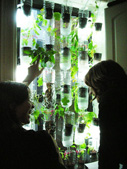food

Food Pyramids
I missed this when it first hit the web, but wow, that’s a striking presentation.
The Physicians Committee for Responsible Medicine published this graphic during the 2007 debate on the US Farm Bill.
Neo Gardenism
At the intersection of urbanism, DIY, food justice and sustainable agriculture, a crop of artists are making open source gardens and sharing instructions on the web and beyond.
 Britta Riley and Rebecca Bray build hydroponic Window Farms from recycled materials. The farms are specifically designed with New York City apartments in mind, and the website invites window gardeners to share photos, plans, designs and information.
Britta Riley and Rebecca Bray build hydroponic Window Farms from recycled materials. The farms are specifically designed with New York City apartments in mind, and the website invites window gardeners to share photos, plans, designs and information.
Edible Estates is a project to convert the classic American front lawn into a productive vegetable garden. Initiated by architect and artist Fritz Haeg on Independence Day, 2005, several prototype gardens were created in different cities across the United States, with instructions and documentation of the prototype gardens posted to the site. 2009 sites have not been announced, but the group is ideally looking for “A monotonous housing development of identical homes... where the interruption of the endless lawn would be dramatic and controversial.”
The Future Farmers’ Victory Gardens project is fought on two fronts: to deliver urban garden kits to urban farmers across San Francisco, and to ultimately develop and maintain a portion of the original Victory Garden space in San Francisco’s Golden Gate Park.
 The Garden is a feature-length documentary film about a 14-acre community garden in South Central Los Angeles that emerged in the wake of the 1992 LA riots. The film chronicles the origins of the plot and the South Central Farmers struggle to prevent it from being demolished.
The Garden is a feature-length documentary film about a 14-acre community garden in South Central Los Angeles that emerged in the wake of the 1992 LA riots. The film chronicles the origins of the plot and the South Central Farmers struggle to prevent it from being demolished.
On the more underground tip, Guerilla Gardening is illicit, nocturnal gardening in a space not your own. guerrillagardening.org lists projects, mostly in London, each with a description, location, photos, and budget. The site includes tips for making your own.

Seed bombing is packing seeds in compressed soil and throwing it into inhospitable or hard to reach places. Artist Liz Christy was the first to use the term in 1973 when she fought urban decay by tossing seed grenades full of sunflower seeds into abandoned New York City lots. Here’s a scan of her original instruction sheet. Christy also co-founded the first community garden in New York City.
 Moss graffiti is also good for damp, urban corners. Anna Garforth has done some beautiful work here. Here’s how to make your own.
Moss graffiti is also good for damp, urban corners. Anna Garforth has done some beautiful work here. Here’s how to make your own.
And onto Gardening 2.0: Landshare is a UK website matching people who want to grown their own food with homeowners with underused space. The site also hosts an active forum for sharing tips and answering questions.
And with your veggies in hand, VeggieTrader is a website for trade, buy or sell homegrown produce.
I’m sure there are many more sites and projects, too. Between the recession and growing concern about industrial food systems, there seems to be something of a renaissance going on here.
The Food Bill
From an interview with Michael Pollan, author of The Omnivore’s Dilemma:
“There’s no question that the way we eat is in large part determined by legislation, the Farm Bill in particular. There’s a set of rules for the food system, and those rules are written into the Farm Bill. Most of us are unaware of this bill and don’t understand how this whole system works. The reason that fast-food is so cheap is in large part because we subsidize the growing of corn and soybeans, which are turned into livestock feed very cheaply, and the former into a very cheap sweetener, in the case of high-fructose corn syrup. So we unwittingly made a set of choices, without any of us really being consulted about how we would eat. It’s no accident that this is a fast-food nation. Policy has a lot to do with it. So if you’re going to change the food system, there is a lot that you, the consumer, can do on your own; but in the end, it will be very important to make changes at the national level.
...I think the people involved don’t want anyone else getting involved. It works really well for them that it’s treated as a parochial piece of legislation only of interest to the senators from Iowa or Nebraska or Illinois. Part of it starts with calling it the “Farm Bill.” Nobody thinks that farming is their issue. They think it’s a piece of legislation of interest to farmers. It should be called the “Food Bill” because it really is about how we get our food. People aren’t aware of the impact of this piece of legislation. If they were, they would pay more attention, and there would be a larger political debate around it. I’m hoping this year there will be.”
It occurs to me that there’s a strong parallel between much action and writing about progressive food and sustainable design. Both seem to focus heavily on personal choices and per project consumption: consuming only vegetables, buying organic or local, vs. consuming only recycled paper, non-toxic printing, using sustainable materials or energy. Along the lines of this previous item, I think these gestures are fine and good, certainly we should become the change we want to see. But surprisingly few concerned eaters and designers turn their attention to policy or legislation.
Cooking with Meme
Women in Eritrea are spreading a more efficient stove design across the country. The new design requires less fuel, retains more heat, and produces less smoke — dramatically reducing respiratory and eye diseases, conserving the forest, and requiring less time for gathering fuel and for cooking.
From IRIN:
“An innovative scheme to convert 500,000 traditional injera stoves across Eritrea will cut thousands of tons of carbon emissions each year and help to conserve the country’s precious supply of firewood.
For centuries, injera — a pancake-like food widely eaten in Eritrea — has been cooked on simple clay stoves, built over an open fire. However, the stoves are smoky, dangerous and require a substantial amount of firewood to burn effectively.
But scientists at the ministry of energy believe they have found a solution. By making a few simple design changes they have increased the efficiency and safety of the stoves — known as mogoggos — by over 100 percent.
 ‘We have added a chimney, so that smoke no longer fills the kitchen, and an insulated firebox to conserve heat,’ Afeworki Tesfazion, the ministry’s research director, told IRIN. ‘We have also improved ventilation, to allow the fire to burn better, so that it uses 50 percent less fuel.’ He said the new stove also burns a wider range of fuels, such as animal dung, twigs and leaves.
‘We have added a chimney, so that smoke no longer fills the kitchen, and an insulated firebox to conserve heat,’ Afeworki Tesfazion, the ministry’s research director, told IRIN. ‘We have also improved ventilation, to allow the fire to burn better, so that it uses 50 percent less fuel.’ He said the new stove also burns a wider range of fuels, such as animal dung, twigs and leaves.
The ministry estimates that each new stove reduces carbon emissions by 0.6 of a ton annually and saves 366 kg of firewood per household each year. The government hopes that every one of the 500,000 households currently thought to own a stove in Eritrea will convert to the new style. If this happens the environmental savings would be enormous.
The health benefits are also significant. Without the thick smoke pouring into their kitchens, women and children are less likely to suffer from the respiratory diseases and eye problems that affected many who used the old stoves.
The new mogoggo is already proving popular. In a scheme run by the government and backed by small grants... dozens are being built in villages around the country every week. More than 5,000 households have already converted.
Under the scheme, village women are taught how to build the stoves themselves. They then teach other women, who teach others and so on. With free labour and free materials — the stoves are made of clay and rocks, which are easily available everywhere — the only cost is the accessories. Metal chimney caps, valves and doors, as well as clay fire grates and cement chimneys, are mostly made locally.
One village taking part is Mehiyaw, in Debub region, close to Eritrea’s southern border. Nearly half of the 160 households in Mehiyaw have already installed new mogoggos. Others in the village hope to do so soon.
Standing in her small, neat kitchen, Miriam Amman, proudly shows off her work. Miriam, a mother of six children, built the stove with help from women from another village one week ago. ‘I love it because there is no smoke in here anymore,’ she says. ‘My clothes are clean and the children can play in here while I cook. Before now nobody would come into the kitchen while the stove was lit. Also we use less wood, so I spend less time gathering it.’
The biggest challenge faced by the government now is to let people know about the new stoves — and persuade them to convert as soon as possible....
The government is setting up a credit plan, to enable families to borrow money to build the stoves now — about US $8 each — and repay the loan when they can afford it. It estimates that the next stage of the project, including training the women and the credit scheme, will cost a further $500,000.
But so far, customers appear satisfied. In Mehiyaw, a group of Miriam Amma’s neighbours and friends crowd into her kitchen to admire her stove . It is larger and more elevated than the old fireplace, which required women — who do all the cooking in traditional Eritrean households — to bend low while preparing food.
In the small outdoor kitchen the stove is alight, but the air is clear. One woman points out the smoke-blackened corrugated tin roof, a reminder of Miriam’s old stove.
‘At first nobody wanted these new mogoggos,’ said Miriam. ‘But now they have seen how well they work, everybody wants one.’”
via the Ashden Awards
Fresh Vegetables for Rotten Cops
Indonesian Police Urged to Grow Veggies
“Cash-strapped police shaking down citizens for some of the green stuff is part of daily life in Indonesia. To deter graft, a police chief wants his officers to develop green thumbs instead.
Bogor Police Col. Anton Bachrul Alam said Friday he was encouraging officers to grow tomatoes, lettuce and flowers at home to supplement their often meager income.
‘Their official wages are barely enough to live on. It’s better than extorting people or taking bribes,’ he said.
Alam said a hydrophonics expert would teach officers and their family to grow plants using nutrient solutions rather than soil, making them easier to harvest. A police cooperative will help them sell their crops, he said.
Bogor has about 3,000 policemen who earn on average one million rupiah ($111) per month.
Indonesia’s security forces are notorious for petty graft, running illegal enterprises and taking bribes from drug smugglers and gambling operators.”
Hard to say if this will cut down corruption — there are plenty of rich, well-fed people in the extortion racket. How about some transparency, accountability, or popular oversight to go with the tomatoes and cash?
Still, I love this idea. In addition to the extra income and food, urban gardens have all kinds of environmental and health benefits. And I love the image of hardened cops showing off a proud bouquet of home grown flowers, swapping gardening tips and recipes in the locker room, or picking on the new guy for his clearly inferior eggplants.



